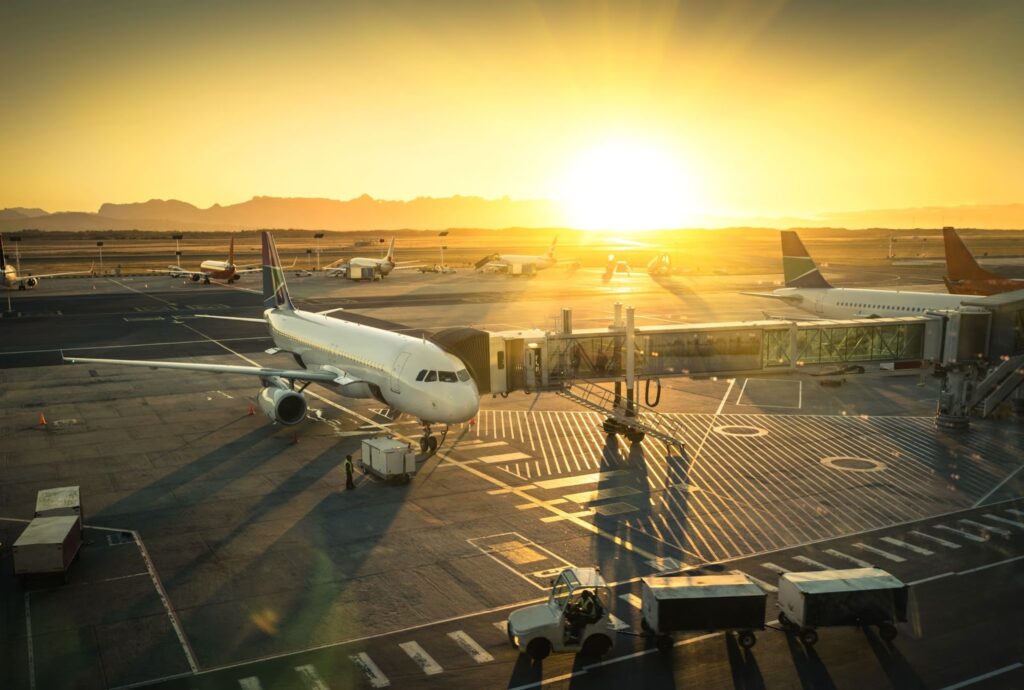Want to know which is the biggest airport in Europe? In this article you can discover a ranking of the 11 largest airports in Europe, based on total area and number of passengers carried annually. Discover them now!
1. Istanbul International Airport – Turkey
Area: 76.5 square kilometres
Number of passengers in 2023: 76 million
In the heart of Europe, at the confluence of East and West, Istanbul International Airport welcomes you, a vital transport hub that brings the world closer to you. With a huge 76.5 million square metres of floor space, it is the largest airport in Europe and the largest in Turkey. Every year, more than 70 million passengers pass through the airport, underlining its importance in the European and global air transport landscape.
Istanbul International Airport is located in the Arnavutkoy district in the European part of Istanbul province. Its accessibility plays an important role in efficiently managing the high volume of traffic. Its strategic location makes the airport a link between Europe and the rest of the world and an important hub in the air transport network.
Although relatively new on the map of Europe’s major airports, Istanbul International Airport has quickly earned its place at the top. Officially opened on 29 October 2018, it was put into full operation on 6 April 2019. As part of this process, all flights from Ataturk Airport have been moved to Istanbul International Airport, marking an important step in the development and expansion of Turkey’s air transport infrastructure. [1, 2]
Planning a trip to Istanbul? You can choose your Wizz Air flights to Istanbul International Airport (IST)! If your journey is affected by certain unforeseen circumstances, such as delays of more than 3 hours, you have the possibility to claim compensation via the Wizz Air compensation form and receive compensation of up to €600, depending on the distance of the flight.
2. Charles de Gaulle Airport – Paris, France
Area: 32.38 square kilometres
Number of passengers in 2023: 68 million
Paris, the city of lights, fashion, art and history, awaits its visitors with open arms. And what better gateway to this fabulous city than Charles de Gaulle Airport? Covering an area of 32.38 square kilometres, it has all the necessary facilities to welcome around 69 million passengers annually.
Charles de Gaulle Airport was built in 1974 and since then it has constantly evolved to provide optimal conditions for those who cross its threshold. It has a wide range of services for travellers, from currency exchange offices, bars and restaurants to duty-free shops, pharmacies, hairdressers, a medical centre and hotels nearby.
Located just 23 kilometres from the French capital, the airport is very accessible. The journey from the terminal to Paris takes about 45 minutes, a very short time compared to other airports in the world. This allows you to make the most of your time in the French capital. [3, 4]
However, as with any large airport, there is the possibility of flight delays. In this situation, you should know that, according to Regulation EC261/2004, you are entitled to compensation in the following situations:
- flight delay of more than three hours;
- denied boarding due to overbooking;
- cancellation of the flight without at least 14 days’ notice;
- loss of a connecting flight due to a delay of one of the previous flights.
3. Barajas Airport – Madrid, Spain
Area: 30.5 square kilometres
Number of passengers in 2023: 60 million
Madrid-Barajas Airport is a jewel of modern architecture and a very important air hub for Spain and the whole of Europe. The airport covers an area of 30.5 square kilometres, serving over 60 million passengers a year. It is not only the busiest airport in Spain, but also one of the largest in the world. With 4 terminals and 4 runways, Madrid-Barajas Airport has the capacity to accommodate up to 70 million passengers annually. It is an airport that never sleeps, pulsating with the energy of travellers from all corners of the world.
You’re just 13 kilometres from the vibrant centre of Madrid. You can reach the city by metro or city bus, making the journey quick and efficient. Due to its proximity to the centre of the Spanish capital, Madrid-Barajas Airport is an ideal departure or arrival point for any trip to Spain. [5,6]
4. Schiphol Airport – Amsterdam, Netherlands
Area: 27.87 square kilometres
Number of passengers in 2023: 61 million
At the heart of the European continent, with a strategic geographical position and a well-developed infrastructure, lies Schiphol Airport, one of the busiest airports in Europe. Every year, more than 60 million passengers pass through its terminal, making it a vital hub for the aviation industry. It is an important hub for leading European airlines such as KLM and Transavia, but also for giants such as EasyJet and Aer Lingus.
Although it has a single terminal, it is divided into three large halls, all connected, from where you can fly to one of 319 destinations. Schiphol is not only a transit point for international travellers but also an essential departure point for domestic travellers. In addition, if you want to visit Amsterdam or other Dutch cities, the airport’s own train station can take you quickly and comfortably to your desired destination. [7,8]
5. Frankfurt Airport – Germany
Area: 23 square kilometres
Number of passengers in 2023: 59 million
Frankfurt Airport is one of Europe’s most important air hubs. When you fly to or from this destination, you’re in the continent’s third busiest airport. Every day, more than 1,300 flights are operated from here.
Frankfurt Airport is also the main hub of the German airline Lufthansa. So, if you fly Lufthansa, you’re likely to have a stopover at this airport. But what really sets Frankfurt Airport apart is the large number of international destinations it serves. There are over 330 destinations you can reach by flying from Frankfurt. [9, 10]

6. Leonardo da Vinci Fiumicino International Airport – Italy area: 14.5 km2
Area: 16 square kilometres
Number of passengers in 2023: 40 million
When you step onto the tarmac at Leonardo da Vinci Fiumicino International Airport, you’re at the largest airport in Italy and one of the busiest in Europe. It is a witness to the history of Italian aviation, being the main base of Alitalia. Its name is an homage to the Renaissance genius Leonardo da Vinci, who in 1480 dreamed up the first flying machine.
Fiumicino is not only a transport hub but also an example of modern and efficient infrastructure. With three terminals for commercial flights and one for charter flights, the airport is ready to accommodate millions of travellers. Here, between flights, you can enjoy a wide range of services: from duty-free shops, to restaurants, car rental offices, currency exchange offices, ATMs and even a chapel.
The link to the heart of Rome is quick and easy. The airport is located 35 kilometres from the centre of this historic city and is easily accessible by train and bus. In addition, the airport offers a connection to Rome’s metro network, making it accessible from any part of the city. [11]
7. Franz Josef Strauss Airport – Munich, Germany
Area: 15.75 square kilometres
Number of passengers in 2023: 37 million
When you think of the busiest airport in Germany, the first one that comes to mind is probably Frankfurt Airport. However, Munich’s Franz Josef Strauss Airport is a real jewel in the crown of German aviation. It is named after Franz Josef Strauss, the former president of Bavaria, and is the second largest and busiest in Germany. Not only that, with over 37 million passengers annually, it plays a key role in connecting Germany with the rest of Europe and the rest of the world.
Franz Josef Strauss Airport has an impressive infrastructure. With two main terminals and two extended runways of 4000 metres each, it is ready to handle a large number of passengers and flights. The main airport buildings, located between terminals, house a variety of services on the south side, while the administration buildings are on the north side.
Although it is the second airport after Frankfurt in terms of passenger traffic, Munich Airport is surprisingly first in terms of domestic flights. Every year, more than 9 million passengers choose this airport to travel within Germany. [12, 13]
8. El Prat Josep Tarradellas Airport – Barcelona, Spain
Area: 15.33 square kilometres
Number of passengers in 2023: 49 million
Barcelona – El Prat Josep Tarradellas Airport is a central point in the European air network, strategically located in the city of El Prat de Llobregat, just 13 km from Barcelona. It is a landmark for Catalonia and one of the largest airports in Spain, second only to Madrid-Barajas.

With an impressive area of 15 square kilometres, the airport is a wide open gateway to the world, welcoming around 50 million passengers annually. With direct flights to major European countries, Canada, USA, South America, Asia and Africa, El Prat Josep Tarradellas airport is a major air hub.
In addition to excellent connections, El Prat Josep Tarradellas airport is also known for its competitive prices. It houses the headquarters of low-cost airline Vueling and the new low-cost airline Level. This presence of low-cost airlines has made the airport one of the most affordable in Europe and a top choice for travellers looking to fly at a reasonable price. [14, 15]
9. Heathrow Airport – London, United Kingdom
Area: 12.27 square kilometres
Number of passengers in 2023: 79 million
London Heathrow Airport opened in 1929 and has managed to rise to the top, becoming one of Europe’s largest airports in terms of annual passenger numbers. Located just 24 km from London, it serves as a major hub for international travellers. With five passenger terminals and one cargo terminal, the airport provides connections to numerous destinations and is served by a total of 90 airlines.
Compared to other airports, Heathrow presents itself proudly but modestly. Although it is the largest airport in Europe in terms of passengers, it has 30 million fewer passengers than the world’s largest airport, Hartsfield-Jackson Airport in Atlanta. [16, 17]
10. Gatwick Airport – Crawley, United Kingdom
Area: 6.7 square kilometres
Number of passengers in 2023: 18 million
When you think of the UK’s largest airport network, the first name that comes to mind is probably Heathrow. However, the second largest and busiest, Gatwick Airport, should not be overlooked. Not only is it the second main option for travellers heading to London, it is also the busiest single-runway airport in the world.

Located in Crawley, West Sussex, Gatwick Airport enjoys a strategic location. Just 46 km south of London and 40 km north of Brighton, its accessibility is one of its main assets. So whether you’re a traveller coming from the British capital or a visitor discovering the beauties of the southern coastline, Gatwick is easy to reach.
But what makes Gatwick Airport really special is its infrastructure. It has two terminals, north and south, connected by a free train service. This makes the movement of passengers easier and makes time at the airport more pleasant and less stressful. [18, 19]
11. Sheremetyevo Airport – Moscow, Russia
Area: 2.5 square kilometres
Number of passengers in 2023: 28 million
When your step takes you deep into the heart of Russia, into the vibrant metropolis of Moscow, Sheremetyevo Airport will most likely be your gateway. It is one of the largest airports in Europe, located in the north-west of Moscow, in the urban district of Khimki, just 34 km from the centre of the capital. Over the years, the airport has experienced impressive expansion, with its location being a decisive factor in its continued growth.
Sheremetyevo is not only large in area, but also in the facilities it offers. The airport consists of several passenger terminals and two cargo terminals. Although there are no hotels directly at the airport, there are plenty of nearby accommodation options designed specifically for passengers with overnight flights or long transfers. [20]
Airports are more than just transport hubs. They are engines of the economy, facilitators of long-distance travel and important players in protecting the environment. Which of these airports have you visited?


